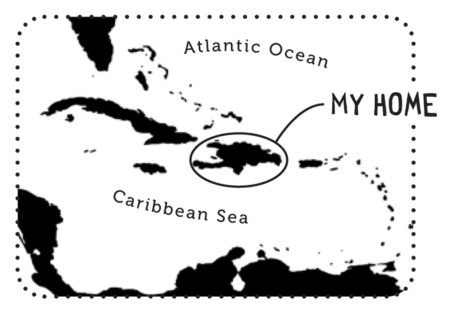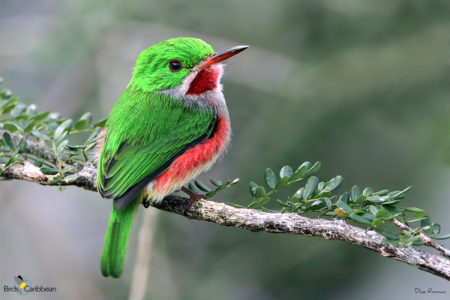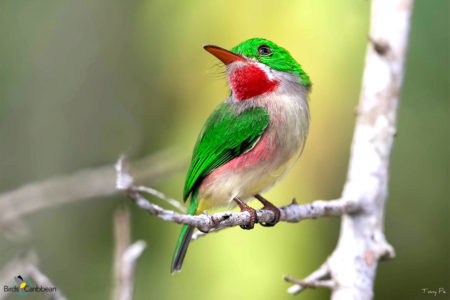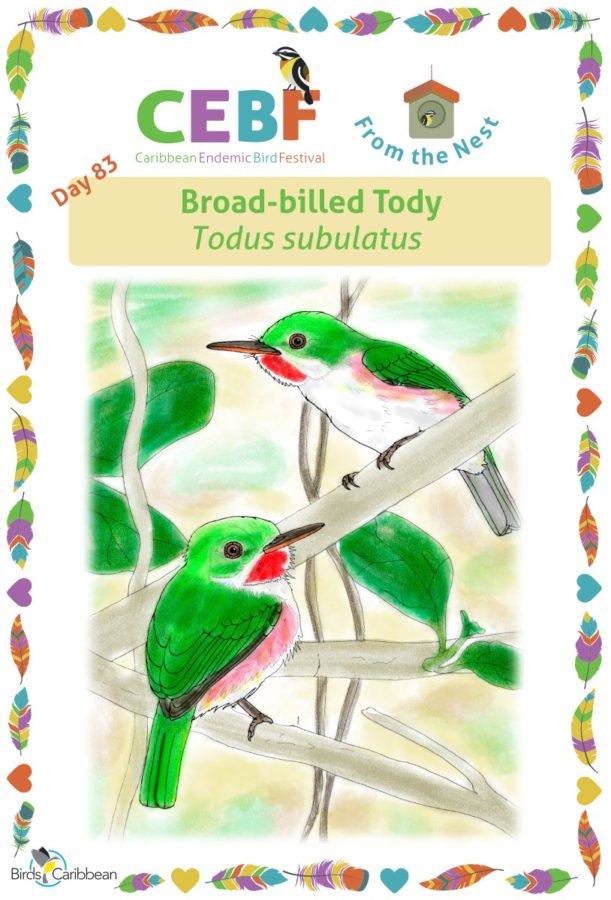Celebrate the Caribbean Endemic Bird Festival (CEBF) with us! Our theme in 2022 is “Loving Birds is Human Nature” Have fun learning about a new endemic bird every day. We have colouring pages, puzzles, activities, and more. Download for free and enjoy nature with your family at home.
Endemic Bird of the Day: Broad-billed Tody

Who’s that beep-beeping in your Dominican yard?? It’s the Broad-billed Tody!
The Broad-billed Tody looks similar to the other todies of the Caribbean, with a bright green back and ruby red throat. However, Hispaniola is the only island with two todies to tease apart instead of one. Where to start? First look at the breast, the Broad-billed Tody has a gray-yellowish wash on the breast whereas the Narrow-billed Tody has a stark white breast. Next check the iris, the Broad-billed Tody has a dark iris contrasting the pale blue of the other species. Finally, look at the namesake bill, the Broad-billed Tody of course has a broader bill that is pale orange underneath whereas the Narrow-billed Tody has a narrower bill with a dusky underside.
If you’re still stumped, take a listen. The Broad-billed Tody gives a monotonous whistled terp-terp-terp-terp call, similar to that of a peeping chick, as well as a chatter call reminiscent of their Kingfisher cousins. The Narrow-billed Tody sounds drastically different, making a succinct staccato call and an insect-like chi-cui sound.
The Broad-billed Tody is the only one of the two species to do a wing flick display, which sounds like running your fingers through a comb. But if you get them really mad they’ll do a threatening fluff display where they’ll take their cotton candy pink flank feathers and fluff them over their wings. The angriest colorful cotton ball you’ve ever seen!
Broad-billed Todies are found throughout Hispaniola at lower elevations in humid tropical forest, dry forest, mangroves, and fragmented landscapes. As their Dominican name implies, the Barrancolí can be found creating nest burrows in dirt banks. And they’re not picky! They’ll take a pile of dirt behind your house or the slope from a recently made trail. They usually nest from April – July, laying 3-4 eggs. They are avid insectivores, constantly sallying from small perches to catch anything flying from mosquitos to butterflies. Interestingly, todies change their diet during the breeding season to include more local fruits and have been found foraging on as many as 27 different kinds!
Their adaptability has allowed them to thrive with increasing urbanization, but they’re still losing habitat to deforestation and face nest predation from invasive mammals like rats and mongoose. Although currently considered by the IUCN as Least Concern, we definitely want to keep an eye on these adorable fluffs. Learn more about this species, including its range, photos, and calls here.
Colour in the Broad-billed Tody
Download our West Indies Endemic Bird colouring page. Use the photos below as your guide, or you can look up pictures of the bird online or in a bird field guide if you have one. Share your coloured-in page with us by posting it online and tagging us @BirdsCaribbean #CEBFfromthenest
Listen to the calls of the Broad-billed Tody
The Broad-billed Tody makes repeated and persistent “terp, terp, terp….” calls.
Puzzle of the Day
Click on the image below to do the puzzle. You can make the puzzle as easy or as hard as you like – for example, 6, 8, or 12 pieces for young children, all the way up to 1,024 pieces for those that are up for a challenge!


Activity of the Day
 FOR KIDS: Can you find the words in our Broad-billed Tody word search? Remind yourself of some of the interesting facts about this endemic bird as you look for all 15 hidden words! Remember the words appear forwards and backwards, as are horizontal, vertical and diagonal! Need some help? Or want to check your answers? You can see where all the words were here.
FOR KIDS: Can you find the words in our Broad-billed Tody word search? Remind yourself of some of the interesting facts about this endemic bird as you look for all 15 hidden words! Remember the words appear forwards and backwards, as are horizontal, vertical and diagonal! Need some help? Or want to check your answers? You can see where all the words were here.
FOR KIDS AND ADULTS: Read all about the problems that invasive mammals can cause to breeding Broad-billed and Narrow-billed Todies in the Dominican Republic. Holly Garrod explains from her first-hand experience, how species such as rats and mongooses could cause decreases in the populations of Todies by predating their nests. Find out more about Holly’s research on Todies in our blog post (link below).
Enjoy the video below of a Broad-billed Tody in the wild! List out for the persistent and slightly disgruntled sounding calls that are typical of these colourful little birds.

